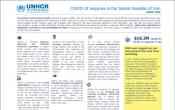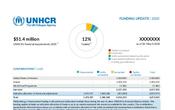Islamic Republic of Iran
Operation: Islamic Republic of Iran
Location
{"longitude":55,"latitude":33,"zoom_level":5,"iso_codes":"'IRN'"}
By clicking on the icons on the map, additional information is displayed.
The boundaries and names shown and the designations used on this map do not imply official endorsement or acceptance by the United Nations.
Key Figures
| 2019 year-end results | |
| 480,000 | Afghan and Iraqi children (including 130,000 undocumented children) were enrolled in Government-run primary and secondary schools |
| 100% | of refugees had access to the Islamic Republic of Iran’s Universal Public Health Insurance (UPHI), while UNHCR supported 92,000 extremely vulnerable refugees to access UPHI through financial contributions |
| 2,400 | refugees received technical and vocational training in more than 40 occupations in 17 provinces |
| 1,900 | Afghans and almost 60 Iraqis voluntarily repatriated |
| 680 | individuals departed for resettlement |
| 2020 planning figures |
| 95% | of people of concern will have access to primary, secondary and tertiary health care |
| 9,500 | people of concern will be trained on SGBV prevention and response |
| 8,000 | Afghan refugees will be facilitated for access to wage earning employment |
| 1,000 | people of concern will receive support to facilitate their departure for resettlement |
| 25 | schools (educational facilities) will be built to enhance capacity of the national education system and facilitate access of additional 9,000 refugee and host community children to school |
Latest Updates
People of Concern
0%
Decrease in
2019
2019
| 2019 | 979,472 |
| 2018 | 979,476 |
| 2017 | 979,525 |

[["Refugees",979435],["Asylum-seekers",33],["Returned refugees",4]]
Loading ...
Islamic Republic of Iran
< Back
2019
{"categories":[2015,2016,2017,2018,2019,2020],"budget":[72.823781737,76.76538033,97.24654417,98.75662219,98.91670641,99.86142491],"expenditure":[21.93132368,36.211779,35.12314787,27.87564296,28.82420805,null]}
{"categories":[2015,2016,2017,2018,2019,2020],"p1":[72.823781737,76.76538033,97.24654417,98.75662219,98.91670641,99.86142491],"p2":[null,null,null,null,null,null],"p3":[null,null,null,null,null,null],"p4":[null,null,null,null,null,null]}
{"categories":[2015,2016,2017,2018,2019,2020],"p1":[21.93132368,36.211779,35.12314787,27.87564296,28.82420805,null],"p2":[null,null,null,null,null,null],"p3":[null,null,null,null,null,null],"p4":[null,null,null,null,null,null]}
Loading ...
CHOOSE A YEAR
- 2014
- 2015
- 2016
- 2017
- 2018
- 2019
- 2020
Operational context
The Islamic Republic of Iran remains the second largest refugee-hosting country in Asia in 2019, and the sixth in the world for refugees under UNHCR’s mandate. While the Government policies for Afghan and Iraqi refugees are inclusive, notably in terms of access to national education and health care, these efforts were significantly affected by an economic situation amidst a complex geopolitical and socio-economic environment.High inflation and broader economic challenges, including those related to the international situation, made it difficult for refugees and host communities to make ends meet and to acquire basic goods and services, such as rent, medicines and medical treatment, transport and food. The most vulnerable refugees were particularly affected. The Government engaged in a proactive solutions dialogue with the Governments of Afghanistan and Pakistan, as well as UNHCR, and supported the establishment of a dedicated Support Platform for the Solutions Strategy for Afghan Refugees (SSAR). Additional international burden- and responsibility- sharing was deemed critical to support the Government in its inclusive refugee policies and to increase the availability of solutions for refugees. This was particularly important in view of the slow pace of voluntary repatriation – some 1,900 individuals returned to Afghanistan in 2019 - and dramatically decreased resettlement quotas, which reached an all-time low since the start of the programme in the Islamic Republic of Iran. Some 680 individuals departed for resettlement in 2019.
In 2019, the Islamic Republic of Iran amended its nationality law to allow children born to Iranian women and non-Iranian men to acquire Iranian nationality, regardless of whether they were born on Iranian territory. This marked a major step towards reducing and preventing statelessness.
Population trends
According to the 2015 refugee population data of the Government, over 951,100 Afghan refugees (Amayesh card holders) and nearly 28,300 Iraqi refugees resided in the Islamic Republic of Iran. The vast majority, 97%, lived in urban areas, while 3% resided in 20 settlements managed by the Government. The annual registration exercise for refugees “Amayesh XIV” was completed in 2019.Approximately 450,000 Afghans with Afghan passports and Iranian visas also resided in the country, in addition to an estimated 1.5 to 2 million undocumented Afghans.
Achievements
- UNHCR collaborated with the Ministry of Education to construct 12 schools and supported literacy courses for more than 3,200 over-age/out-of-school refugees.
- In collaboration with the Ministry of Health, all refugees continued to benefit from free quality primary health care in settlements and urban areas.
- UNHCR continued to support some 100 primary health posts by supplying medicines. It also supported the cost of essential staff and other medical supplies at 27 primary health posts.
- In coordination with the Government’s Bureau for Aliens and Foreign Immigrants Affairs, free legal support for refugees was provided in 16 provinces.
- In response to severe floods in 24 provinces, UNHCR supported the five most affected refugee hosting provinces with core relief items, as well as the construction of a school and health post.
Unmet needs
- The operation was funded at only 33% by the end of 2019. The operation was caught between sharply increasing needs and funding constraints.
- Cash assistance had to be prioritized among the most extremely vulnerable cases due to limited resources. In 2019, over 2,800 households received multi-purpose cash assistance from UNHCR.
- In 2019, only 12 schools were co-funded by UNHCR, significantly below the overall needs identified by the Government to accommodate all refugee children in the national system.
- UNHCR’s support to the Ministry of Health and Medical Education for primary health care provision was limited to the construction of one health post and one child delivery center; support to essential health personnel in targeted health posts; and the procurement of essential drugs. At the level of secondary and tertiary health care, UNHCR could only partially cover refugees’ treatment costs through support to specialized local NGOs in the medical sector. Needs remained higher, especially as costs for medicines and medical treatment increased considerably during the year.
- With assessed needs for livelihood support for 5,000 refugees, UNHCR could assist only 2,900 through vocational training and income generation opportunities - despite the rapidly increasing living costs and decreasing livelihood opportunities.
Working environment
The Islamic Republic of Iran hosts one of the largest and most protracted urban refugee populations in the world, largely from Afghanistan. Of the close to 1 million Afghan refugees in Iran, 97 per cent live in urban areas while 3 per cent reside across 20 settlements managed by the Government. Approximately 450,000 Afghans who hold Afghan passports with Iranian visas also live in Iran as well as an estimated 1.5 to 2 million undocumented Afghans, of which 800,000 participated in a headcount exercise initiated by the Government in 2017 as part of a process to regularise the undocumented foreign population in Iran. UNHCR stands ready to support the Government in any future activities on this. There is also a smaller population of refugees from Iraq.The Islamic Republic of Iran has included refugees into its primary health care (PHC) system and UNHCR supports efforts of the Ministry of Health, to ensure quality PHC services are available to, and further expanded to refugees. Since 2015, refugees have also had access to the national universal health insurance scheme. The inclusion of universal health coverage, including for refugees, is within the 6th National Development Plan. Activities implemented jointly by UNHCR, the Government, and local NGOs in the areas of secondary and tertiary healthcare, and harm reduction all contribute to support the Government to provide improved and quality access to healthcare for all refugees in the Islamic Republic of Iran.
UNHCR continues to support the Government in order to accommodate the formal and non-formal education of the large population of Afghan and Iraqi refugee children, through supporting construction of schools and access to literacy training. Refugees and foreign children have access to the national education system at the same level with nationals. While national schools have been welcoming refugees, construction of additional space and procurement of necessary equipment and materials stretch the already limited resources.
The Government of Iran has over the past years introduced increasingly inclusive and progressive refugee policies, enabling refugees to access national services, primarily in the areas of health and education. UNHCR continues to work under the framework of the Solutions Strategy for Afghan Refugees. In a quadripartite meeting between UNHCR and the Islamic Republics of Afghanistan, Iran and Pakistan, in December 2017, it was agreed to extend the strategic framework for the 2018 and 2019. Details of the extension are elaborated in the UNHCR regional plan, Enhancing Resilience and Co-Existence through Greater Responsibility Sharing, which, in line with recent global developments, places enhanced emphasis on international responsibility sharing. Furthermore, focus remains on voluntary repatriation in safety and dignity as the preferred solutions for the Afghan refugees, and on providing assistance to refugees, host communities and host countries in the meantime.
The Government of Iran conducted headcount exercise of foreign nationals with specific category in 2017, primarily Afghans, during which the identified undocumented population was estimated at 800,000 people. The Government has shown willingness to engage with UNHCR in identifying most appropriate legal status and documentation for this population starting in October 2018.
Key Priorities
In 2019, UNHCR will focus on:- Supporting implementation of the inclusive refugee policies of the Government of Iran, for refugees to access health care, health insurance and education. This will include supporting the Government’s efforts to continue extending the national health insurance scheme to refugees by subsidising the insurance premium of identified extremely vulnerable refugees while working with the government to seek sustainable solutions, i.e. addressing affordability of the insurance premium; and supporting the Government’s efforts to enhance the capacity of the national education system to absorb addition children, through construction of education facilities.
- Support the government of Iran in its effort to regularize and document the undocumented Afghan population in Iran while also exploring to establish a safe-guard system to identify persons in need of international protection. This will include access to birth registration and assisting refugees in obtaining other civil registration;
- Improve access to livelihoods, through enhancing refugee enrolment into cross border job placement programmes and increase in diversified livelihoods opportunities; as well as in demand-driven vocational and technical education programs with on the job training.
- Expanding and exploring access to durable solutions for the Afghan population, including through voluntary repatriation, resettlement, and complementary legal pathways to third countries.
























